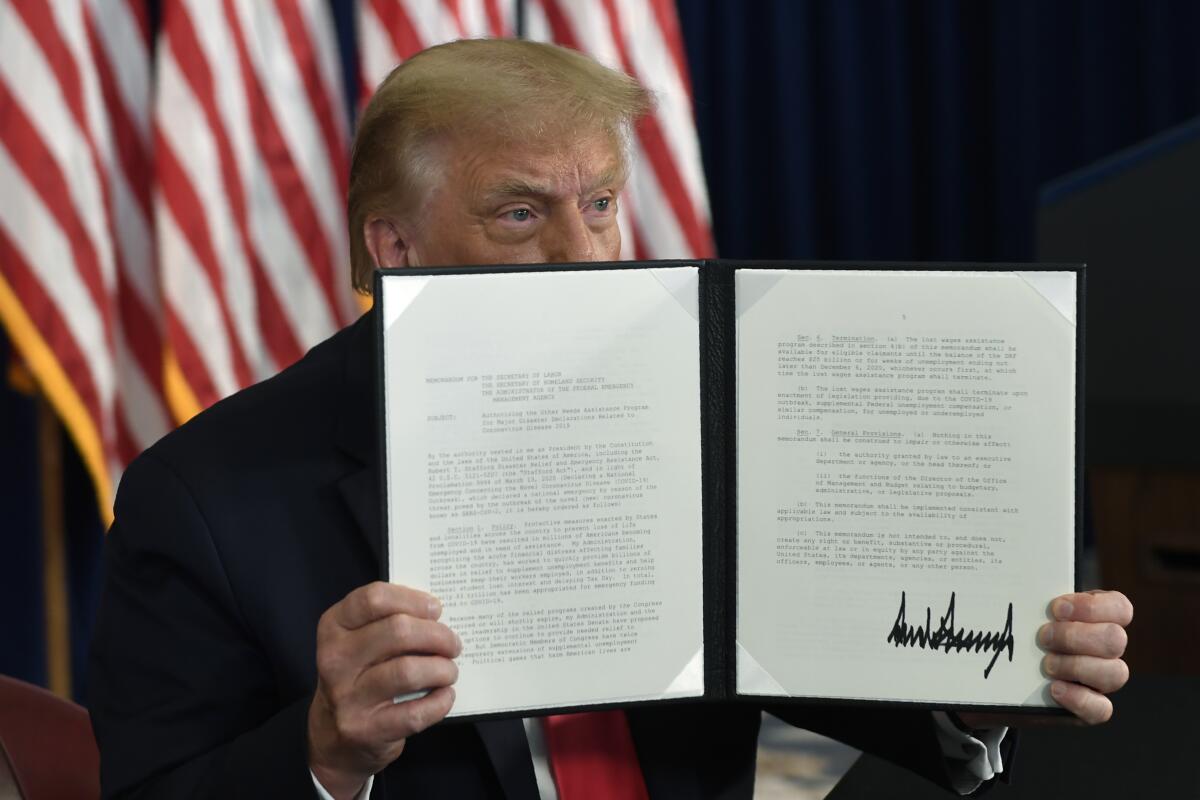Trump’s rescue plan would let state and local governments drown in red ink

- Share via
The pandemic rages on. Millions of laid-off Americans teeter on the edge of financial disaster now that extended unemployment benefits have ended. The courts and homeless shelters are preparing for a tsunami of evictions now that federal eviction moratoriums have expired. State and local governments are facing layoffs and service cuts because tax revenue has plummeted.
The nation needs a major infusion of federal funding to keep communities afloat. Instead, over the weekend, President Trump put forth a handful of executive orders that will provide little immediate relief.
The orders earn Trump a participation trophy, but not much beyond that. He simply doesn’t have the authority to do much of what needs to be done now, which is to spend, spend, spend. Congress holds the purse strings, and so far lawmakers haven’t been able to make a deal.
The Democratic-led House passed a $3.4-trillion spending plan in May that would have extended the $600 per week in extra unemployment benefits, bailed out struggling state and local governments, helped renters pay their landlords and kept the Postal Service afloat.
Senate Republicans, however, have insisted on being penny-wise and pound-foolish. They offered a $1-trillion proposal that would have slashed the extra unemployment assistance to $200 a week and offered no aid for cities and states. Unable to negotiate a compromise, President Art of the Deal tried to paper over the impasse with executive orders.
Take, for example, his move to extend unemployment benefits. Trump couldn’t revive the $600-per-week supplement with the stroke of a pen; instead, he invited states to apply for more federal disaster relief dollars to use for extra benefits. The catch: The benefits would go up only $400 a week, and cash-starved states would have to cover a quarter of the cost. If the states can’t pay, their residents won’t get the extra aid. The cost to California, where more than 4.6 million people are receiving benefits, would be in the billions of dollars.
Similarly, Trump can’t unilaterally cut payroll taxes, he can just delay their collection. That’s what he did for low- and moderate-income workers, allowing them to run up a payroll tax tab that they would not have to pay until next year. But employers apparently are still obligated by law to withhold and submit the taxes, so it’s not clear what Trump accomplished.
His order on evictions is also toothless. It did nothing to revive a federal eviction moratorium that expired last month, and there was no commitment of funds to help renters pay their landlords. Instead, the order directed agencies to consider an eviction moratorium and identify funds that could be used for emergency rental assistance. But tenants and landlords need immediate assistance, especially now that the extra unemployment benefits have evaporated.
One exception to the otherwise lackluster executive orders: Trump can and did extend the relief to Americans with student loans held by the federal government, suspending payments and waiving interest through the end of the year.
A big sticking point in the negotiations over the next relief bill has been the Democrats’ demand for money to help cities and states avoid brutal budget cuts. GOP leaders have been cool to the idea, with Trump saying last month that he didn’t want to “reward badly run radical left Democrats.”
But that kind of punitive, politically motivated and short-term thinking will just end up hurting communities across the country that are on the front lines of fighting COVID-19.
State and local governments generate much of their revenue from taxes on sales, business receipts and tourism. That economic activity ground to a halt as the pandemic surged, and tax revenue has fallen off a cliff. In a new survey of California cities, the budget shortfalls will prompt 90% of cities in the state to cut staff or decrease services. Nearly 75% of cities said they may have to do both.
The pandemic continues to wreak havoc on communities. This is no time for penny pinching. The president and lawmakers need to keep the money flowing to stabilize families and communities and prevent lasting damage.
More to Read
A cure for the common opinion
Get thought-provoking perspectives with our weekly newsletter.
You may occasionally receive promotional content from the Los Angeles Times.






